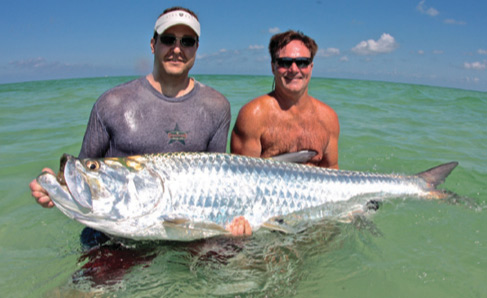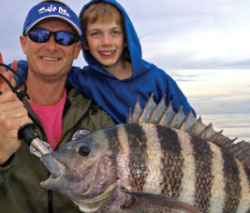The man who has caught trout, black bass, or salmon and has added to this the delight of shore fishing for tautog, bluefish or striped bass, has many pleasant and exciting contests to remember; but if he should once get fast to a tarpon all his other fishing experiences –desperate as some of them may have seemed–will be eclipsed in a moment.
Charles F. W. Mielatz
Excerpt from Tales of Old Florida
The tarpon’s image of ferocity would seem to be immor- tal through the halls of time. Their faces cut from cold steel and scales forged from ice and angular jaws molded and hardened from gray clay. Ice water runs through their veins and more than one angler has tossed in their hats of all shapes and sizes, giving up hope of besting the great Silver King.
The annual tarpon migration north- ward from their Caribbean homes, gives all of us chills. I lay awake at night dreaming of daisy-chaining fish, languidly swimming by my skiff with my client poised to strike, fly rod in hand and the Great Sábalo willingly eating hand spun flies from the night before. It’s a dream we have all had and while fly-fishing is, in my opinion, the best way to fish for tarpon, others would disagree. I asked several cap- tains around the bay how they prefer to count tarpon jumps and on that rare occasion, get a fish boatside.
CAPTAIN BRET GAMROT
Crabs are awesome! “I begin by checking the lunar tables for May and June. As the full and new moons ap- proach, I check the tides to see when the bay is really flushing out, and then I go crab scooping. The best crabs are no larger than an iPhone and I tend to pass on the really big ones. Recently I purchased a telescoping net that reaches well over twenty feet, you know I never miss a crab! I scoop the crustaceans and leave them in the net and once I have enough, in the bucket they go. Then I go to work on their claws. Using my pliers, I squeeze them until the crabs detaches and voila, tarpon candy.”
Tip: “Even if you don’t have any crabs, just get out there. You can just net one that has been flushed and get a hook in it, then just do your drift over and net another. Pretty soon you will have a bucket load of crabs. Just be sure not to miss the bite, which will peak during the hill tides surround- ing the full and new moons. If the crabs are flushing, the poons are eating. Happy crabbin.
Captain Bret Gamrot
(727) 647-2524
www.onshoreoffshore.com
CAPTAIN CLAY EAVENSON
Tarpon Tides. “If I had to name the most impor- tant factor, when it comes to getting on a great tarpon bite, it would be, hands down, the tide. It’s not just as simple as the incoming tide be- ing good or strong, or the outgoing being fast and furious. Each spot that tarpon frequent has a particular tide that is ideal for it.
There some places that tarpon will fire off on a slow incoming or outgo- ing, then there are spots where you need rush- ing white water to get those silver beasts to eat. Learning what the best tides are for your particular area is essential to success. Understanding the tides fully will only come with time and ex- perience. Be sure to fish your tarpon spots thoroughly, on every tide possi- ble, making sure to keep track of what tide and time of day works best.”
Tip: “Take it to the next level. Start figuring out which bait works best at each spot and each tide. Dead bait, cut bait, live bait, crabs, pilchards, ladyfish, mullet, it can take time to learn, sometimes years, to get best combination of tide, location and bait. Once you do figure out the key in- gredients, your efforts will be greatly rewarded.”
Captain Clay Eavenson
(813) 300-2147
www.captainclay.com
CAPTAIN TIM WHITFIELD
“I prefer to fish for tarpon a little differently than most. I like hunting them in the backwaters using artifi- cial lures, mainly D.O.A. Bait Busters. Fishing in the solitary confinement of a deep dark river is more pure than any other method of tam- ing silver, other than catching them on fly. I look for rolling fish and glide on the electric motor up current, way up current. Drifting back using the helm to steer, we toss and swim the baits slowly back to the boat. This covers a lot of water and keeps the bait in the strike zone for a longer period of time. In my opinion, this has to by simple math, increase the chances of hook- ing up but then again, I am no longer there to catch fish. I find I leave a little bit of my soul when I am stalking the great one and again, at times I think I am gaining some of it back. It has become seasoned by the waters and I feel it coursing through my veins.
Captain Tim Whitfield
(813) 714-0889
www.swiftfishcharters.com
And as for me? Well, as I said before, I prefer to chuck fluff at my tarpon. Sitting up late at night at the vice, tying deer hair and rabbit zonker into crab or baitfish pat- terns is just part of my job, much the same as waking up early and netting thousands of pilchards or netting dozens of crabs.
Tying flies has become a part of who I am, just as the tarpon migration has become a part
of most every guide this side of the Mason- Dixon. The tarpon come when the Gardenias bloom and stay for some of the finest weather the state has to offer and more than that, they provide a much welcomed change of pace for those of us who strive to bring awesome fish- ing experiences to thousands of eager tourists and vacationers.
Captain Johnny makes his living from the deck of his skiff and in the woods around his home in Tampa. If you are interested in booking a fishing experience with him, you can visit his website www.LPineOutdoors.com or call him at (813) 713-0237.
Read this article chock full of imagery on our digital magazine by clicking here





